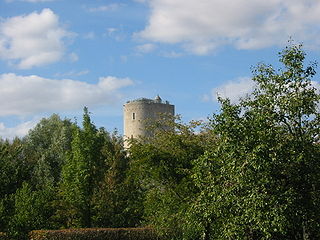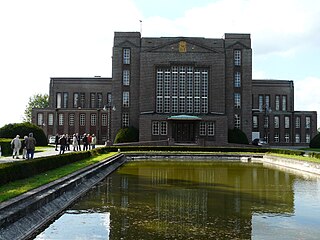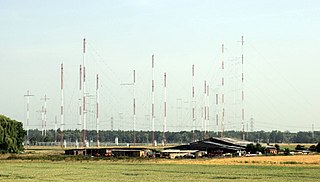
Shortwave radio is radio transmission using shortwave (SW) radio frequencies. There is no official definition of the band, but the range always includes all of the high frequency band (HF), which extends from 3 to 30 MHz ; above the medium frequency band (MF), to the bottom of the VHF band.
International broadcasting, in a limited extent, began during World War I, when German and British stations broadcast press communiqués using Morse code. With the severing of Germany's undersea cables, the wireless telegraph station in Nauen was the country's sole means of long-distance communication.

Digital Radio Mondiale is a set of digital audio broadcasting technologies designed to work over the bands currently used for analogue radio broadcasting including AM broadcasting—particularly shortwave—and FM broadcasting. DRM is more spectrally efficient than AM and FM, allowing more stations, at higher quality, into a given amount of bandwidth, using xHE-AAC audio coding format. Various other MPEG-4 and Opus codecs are also compatible, but the standard now specifies xHE-AAC.
JJY is the call sign of a low frequency time signal radio station located in Japan.

Radio Netherlands was a public radio and television network based in Hilversum, producing and transmitting programmes for international audiences outside the Netherlands from 1947 to 2012.
Shortwave broadcasting in the United States allows private ownership of commercial and non-commercial shortwave stations that are not relays of existing AM/MW or FM radio stations, as are common in Africa, Europe, Asia, Oceania except Australia and Latin America. In addition to private broadcasters, the United States also has government broadcasters and relay stations for international public broadcasters. Most privately owned shortwave stations have been religious broadcasters, either wholly owned and programmed by Roman Catholic and evangelical Protestant charities or offering brokered programming consisting primarily of religious broadcasters. To better reach other continents of the world, several stations are located in far-flung US territories. Shortwave stations in the USA are not permitted to operate exclusively for a domestic audience; they are subject to antenna and power requirements to reach an international audience.

Allouis is a commune in the Cher department of the Centre-Val de Loire region of France.

Issoudun is a commune in the Indre department, administrative region of Centre-Val de Loire, France. It is also referred to as Issoundun, which is the ancient name.
HCJB, "The Voice of the Andes", was the first radio station with daily programming in Ecuador and the first Christian missionary radio station in the world. The station was founded in 1931 by Clarence W. Jones, Reuben Larson, and D. Stuart Clark. HCJB now focuses on Ecuador with unified programming on FM at 89.3 MHz in Pichincha, at 92.5 MHz in Manabí, at 96.1 MHz in Tungurahua and Cotopaxi, at 98.3 MHz in Esmeraldas and with separate programming on AM at 690 kHz. Broadcasts in Spanish and indigenous languages on 6.05 MHz (1 kW), continue on an intermittent basis with a new solid state transmitter which in 2017 replaced an older (5 kW) transmitter. These broadcasts were not listed on the HCJB English website as of February 2016.
A television transmitter is a transmitter that is used for terrestrial (over-the-air) television broadcasting. It is an electronic device that radiates radio waves that carry a video signal representing moving images, along with a synchronized audio channel, which is received by television receivers belonging to a public audience, which display the image on a screen. A television transmitter, together with the broadcast studio which originates the content, is called a television station. Television transmitters must be licensed by governments, and are restricted to a certain frequency channel and power level. They transmit on frequency channels in the VHF and UHF bands. Since radio waves of these frequencies travel by line of sight, they are limited by the horizon to reception distances of 40–60 miles depending on the height of transmitter station.
A broadcast transmitter is an electronic device which radiates radio waves modulated with information content intended to be received by the general public. Examples are a radio broadcasting transmitter which transmits audio (sound) to broadcast radio receivers (radios) owned by the public, or a television transmitter, which transmits moving images (video) to television receivers (televisions). The term often includes the antenna which radiates the radio waves, and the building and facilities associated with the transmitter. A broadcasting station consists of a broadcast transmitter along with the production studio which originates the broadcasts. Broadcast transmitters must be licensed by governments, and are restricted to specific frequencies and power levels. Each transmitter is assigned a unique identifier consisting of a string of letters and numbers called a callsign, which must be used in all broadcasts.

ALLISS is a somewhat rotatable antenna system for high power shortwave radio broadcasting in the 6 MHz to 26 MHz range. An ALLISS module is a self-contained shortwave relay station that is used for international broadcasting.
WRMI is a shortwave radio station broadcasting from Okeechobee, Florida, United States. WRMI is a commercial radio station that sells airtime to businesses and organizations.

ALS162 is a French longwave time signal and standard-frequency radio station and is used for the dissemination of the Metropolitan French national legal time to the public. TéléDiffusion de France broadcast the ALS162 time signal, provided by LNE-SYRTE and LNE-LTFB time laboratories under ANFR responsibility, from the Allouis longwave transmitter at 162 kHz, with a power of 800 kW.

Radio Ukraine International, abbreviated RUI, is the official international broadcasting station of Ukraine.

Nauen Transmitter Station in Nauen, Havelland district, Brandenburg, Germany, is the oldest continuously operating radio transmitting installation in the world. Germany's first high power radio transmitter, it was founded on 1 April 1906 by Telefunken corporation and operated as a longwave radiotelegraphy station through World War II, and during World War I became Germany's main link with the outside world when its submarine communications cables were cut. Upgraded with shortwave transmitters in the 1920s it was Germany's most advanced long range radio station, continually upgraded with the latest equipment and serving as an experimental station for Telefunken to test new technology. At the end of World War II, invading Russian troops dismantled and removed the transmitting equipment. During the Cold War it served as the GDR's international shortwave station Radio Berlin International (RBI), and was the East Bloc's second most powerful radio station, disseminating Communist propaganda to other countries. Since German Reunification in 1991 it has been operated by Deutsche Telekom, Germany's state telecommunication service. The original 1920 transmitter building designed by architect Herman Muthesius is still used; it is the only remaining building designed by that architect.

CKCX was the call sign used for the Canadian Broadcasting Corporation's shortwave transmitter complex near Sackville, New Brunswick at the Tantramar Marshes. The Sackville Relay Station was operated by Radio Canada International and broadcast its programming around the world as well as relay transmissions from several foreign shortwave broadcasters. Domestically, it transmitted broadcasts on 9.625 MHz to northern Quebec by CBC North, the James Bay Cree Communications Society and Taqramiut Nipingat, the Inuit communications society of the Nunavik region of northern Quebec. The CKCX designation was assigned after CBC Radio's CBA, under whose licence the Sackville complex originally operated, moved to Moncton in 1968. Sackville was also used by Radio Japan, China Radio International, Voice of Vietnam, BBC World Service, Deutsche Welle and Radio Korea as part of a transmitter time exchange agreement.
RDP Internacional - Rádio Portugal, is an international radio broadcasting station of Rádio e Televisão de Portugal. It aims at overseas Portuguese communities in Europe, Africa, South America, North America, India/Middle East as well as East Timor.

Curtain arrays are a class of large multielement directional radio transmitting wire antennas, used in the shortwave radio bands. They are a type of reflective array antenna, consisting of multiple wire dipole antennas, suspended in a vertical plane, often in front of a "curtain" reflector made of a flat vertical screen of many long parallel wires. These are suspended by support wires strung between pairs of tall steel towers, up to 90 m high. They are used for long-distance skywave transmission; they transmit a beam of radio waves at a shallow angle into the sky just above the horizon, which is reflected by the ionosphere back to Earth beyond the horizon. Curtain antennas are mostly used by international short wave radio stations to broadcast to large areas at transcontinental distances.

The Leicester Peak transmitting station is a broadcast transmitting station and communications relay station located near Freetown, Sierra Leone. The site is owned by the Sierra Leone Broadcasting Corporation the country's state broadcaster. It is now the primary transmitting station providing broadcast services for the Western Area of Sierra Leone. Previously the SLBC operated a shortwave transmitting station in Waterloo and a shortwave/mediumwave station in Goderich.
















